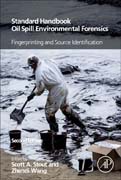
Standard Handbook Oil Spill Environmental Forensics: Fingerprinting and Source Identification
Stout, Scott
Wang, Zhendi
Standard Handbook Oil Spill Environmental Forensics: Fingerprinting and Source Identification, Second Edition, provides users with the latest information on the tools and methods that have become popular over the past ten years. The book presents practitioners with the latest environmental forensics techniques and best practices for quickly identifying the sources of spills, how to form an effective response, and how to determine liability. This second edition represents a complete overhaul of the existing chapters, and includes 13 new chapters on methods and applications, such as emerging application of PAHi isomers in oil spill forensics, development and application of computerized oil spill identification (COSI), and fingerprinting of oil in biological and passive sampling devices. Contains 13 new chapters on methods and applications, including emerging application of PAH isomers in oil drill forensics, the development and application of computerized oil spill identification (COSI), and the fingerprinting of oil in biological and passive sampling devicesPresents the latest technology and methods in biodegradation of oil hydrocarbons and its implications for source identification, surface trajectory modeling of marine oil spills, and identification of hydrocarbons in biological samples for source determinationContains new case studies to illustrate key applications, methods, and techniques INDICE: Chapter 1: Spill Site Characterization in Environmental Forensic Investigations Chapter 2: Sampling Procedures for Securing Evidence for Waterborne Oil Spill Identifications Chapter 3: Chemical Fingerprinting Methods and Factors Affecting Petroleum Fingerprints in the Environment Chapter 4: Petroleum Biomarker Fingerprinting for Oil Spill Characterization and Source Identification Chapter 5: Polycyclic Aromatic Hydrocarbon Homolog and Isomer Fingerprinting Chapter 6: Polycyclic Aromatic Sulfur Heterocycles as Source Diagnostic of Petroleum Pollutants in the Marine Environment Chapter 7: Forensic Studies of Naphthenic Acids Fraction Compounds in Oil Sands Environmental Samples and Crude Oil Chapter 8: Applications of Comprehensive Two-Dimensional Gas Chromatography (GC×GC) in Studying the Source, Transport, and Fate of Petroleum Hydrocarbons in the Environment Chapter 9: Oil Fingerprinting Analysis using Gas Chromatography-Quadrupole Time-of-Flight (GC-QTOF) Chapter 10: Application of Isotopic Compositions in Fugitive Petroleum Product Identification and Correlation Chapter 11: Chemical Fingerprinting of Gasoline and Distillate Fuels Chapter 12: Forensic Fingerprinting of Biodiesel and Its Blends with Petroleum Oil Chapter 13: Chemical Character of Marine Heavy Fuel Oils and Lubricants Chapter 14: CEN Methodology for Oil Spill Identification Chapter 15: Development and Application of On-Line Computerized Oil Spill Identification - COSIWeb Chapter 16: A Multivariate Approach to Oil Hydrocarbon Fingerprinting and Spill Source Identification Chapter 17: Advantages of Quantitative Chemical Fingerprinting in Oil Spill Identification and Allocation of Mixed Hydrocarbon Contaminants Chapter 18: Statistical Analysis of Oil Spill Chemical Composition Data Chapter 19: Biodegradation of Oil Hydrocarbons and Its Implications for Source Identification Chapter 20: Photochemical Effects on Oil Spill Fingerprinting Chapter 21: Oil Spill Remote Sensing: A Forensics Approach Chapter 22: Water Column Sampling for Forensics Chapter 23: Forensic Trajectory Modeling of Marine Oil Spills Chapter 24: Identification of Hydrocarbons in Biological Samples for Source Determination
- ISBN: 978-0-12-809659-8
- Editorial: Academic Press
- Encuadernacion: Cartoné
- Páginas: 1140
- Fecha Publicación: 27/01/2016
- Nº Volúmenes: 1
- Idioma: Inglés
